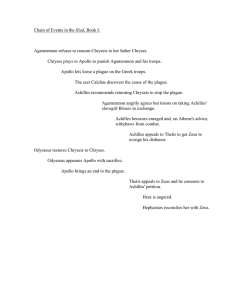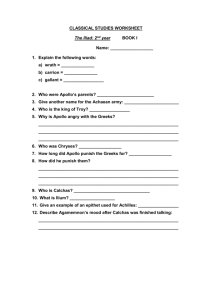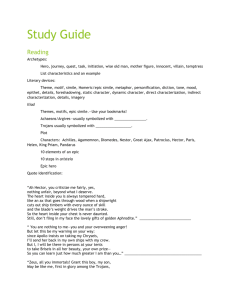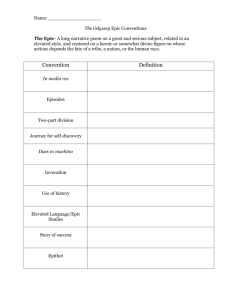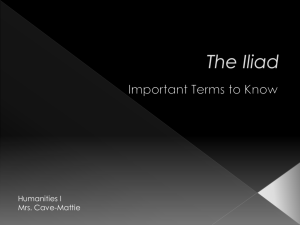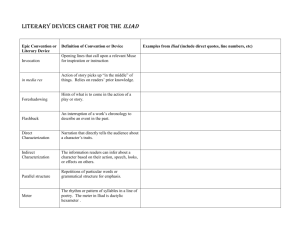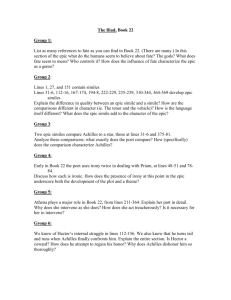Iliad
advertisement
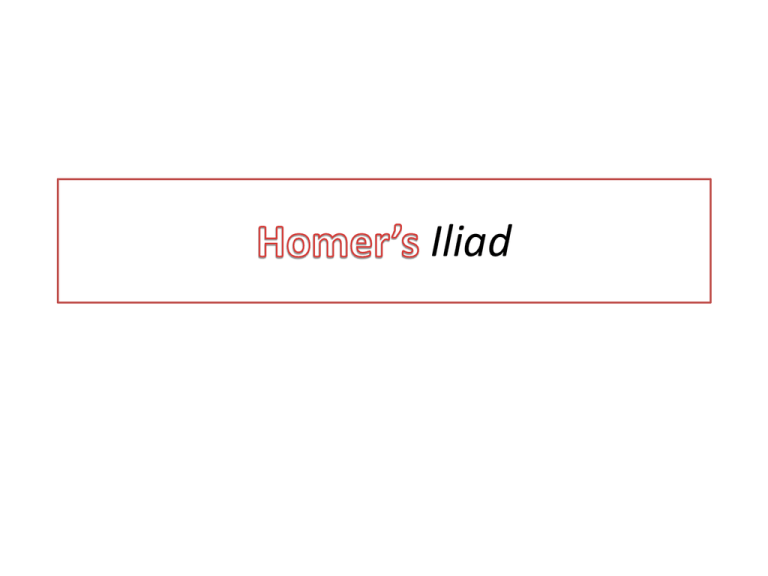
Iliad Re-cap of Book I • Apollo is mad that Agamemnon (son of Atreus) has stolen Chryseis (daughter of Apollo’s priest, Chryses) • Chryses comes to the camp and says that the Achaians can still conquer Troy, but will have to return his daughter (in exchange for a good ransom) in order to appease Apollo • Agamemnon initially refuses • Chryses prays to Apollo; Apollo gets really mad; starts shooting up ships with his arrows • Nine days of this Re-cap, cont’d • Achilles gets everyone together • Kalchas (Thestor’s son) explains that Agamemnon has angered Apollo • Agamemnon is mad, but agrees to give back Chryseis. He demands another concubine is given to him in her place, though • Achilles opposes this, so Agamemnon takes Achilles’ lover, Briseis • Achilles is very sad and withdraws from the fighting, and prays to his mother (Thetis) that she will ask Zeus to make sure that the Achaians don’t win the fight without him • Zeus reluctantly agrees (he owes Thetis a favour) Epic Poetry • General definition: stories that enchant; often feature both humans and gods; memorialize events and legends • “Epic” = Western imposition on the natural heterogeneity of long narrative forms from varying cultures • From the Greek “epos” = word, tale • Or “epopoiia” = verse composition Epic, continued • Has existed as a genre since the time of Aristotle • Epic is not wholly definitive; rather, is openended and varies from culture to culture (diction, especially, as well as narrative patterns) • No one final definition of “epic” Lauri Honko’s definition of ‘epic’: • “epics are great narratives about exemplars, originally performed by specialized singers as superstories which excel in length, power of expression and significance of content over other narratives and function as a source of identity representations in the traditional community or group receiving the epic” Epic, continued • Often feature heroic action/achievement • Tend to idealize characters (sometimes as a way of bolstering national character or group identity) (e.g., Iliad about Achaean achievement in battle; Odyssey memorializes an arduous homeward journey) • The actions of the characters (the heroes) trace a culture’s self-concept in hyperbole (exaggeration) and metaphor Book I • We enter the story after nine years’ of fighting between the Greeks and the Trojans • Literary device known as In Media Res In Media Res • Latin(into the middle of things) • The story begins either at the mid-point or at the conclusion, rather than at the beginning • Setting, character, and conflict are presented through flashback and tell-all (expository) conversations • Stylistic convention associated with epic poetry in general, the Iliad in particular Purpose of disturbing chronology? • More dramatic • Helps compress time for the sake of brevity • E.g. the 10 years of the war is compacted first into 40 days, then 10 days, then 3 days • Helps pinpoint the real climax, the fulcrum of the story Themes • Anger (example?) • Pride (example?) • Human failing versus supernatural omnipotence Metre Dactylic Hexameter • This metric form defines epic poetry • Homeric line (in original Greek) has six poetic “feet” • First five feet are dactyls (one long + two short syllables); last foot has two syllables (either long + short or long + long) • Looks like: –uu/-uu/-uu/-uu/-uu/-x Dactyl = finger or toe Sounds like …. • “Dum-diddy” • Dactylic hexameter: –uu/-uu/-uu/-uu/-uu/-x Dum-diddy/dum-diddy/dum-diddy/dum-diddy/dum-diddy/dum-dum • Virtually impossible to recreate in English Stichic v. Stanzaic • Epics are stichic each line has the same metrical form, and the poem is not broken up into stanzas • (In opposition to stanzaic, where each stanza is the same, but not necessarily each line) Repetition in the Iliad – Of both single lines and longer passages – Relates to the cadences of oral speech (poem originally intended to be performed, recited) – Poem might have only been written down after being repeated orally – Agamemnon called “King of Men” 37 times in I, O; Achilles called “Swift-footed” 31 times in I, O (what purpose? Maybe helped people remember who characters were using specific adjectival phrases) Metaphor • One thing stands in for another • For example: “my love is the ocean, deep and wide” Simile • Compares one thing to another using “like” or “as” • For example: “my love is like a red , red rose” • “I’m as happy as a clam” Metaphor/Simile in Epics • No direct, detailed description in Greek lit. – all done through simile and metaphor • Homer’s similes are distinctive; often align chaos of the present with nature scenes Examples: • Apollo descends on the Greeks “like night” (I.47) • Hector goes on his way “like a snowy mountain” (13.754) Next time: • • • • Book I of the Odyssey Odysseus still not home from the Trojan War Many ‘suitors’ trying to woo his wife, Penelope Odysseus’ son, Telemachus, tries to find out what has happened to his father • Odysseus has been held captive for seven years by Calypso • Start the Aeneid
